141010 Possible Presentation Topics
- 格式:docx
- 大小:18.69 KB
- 文档页数:4


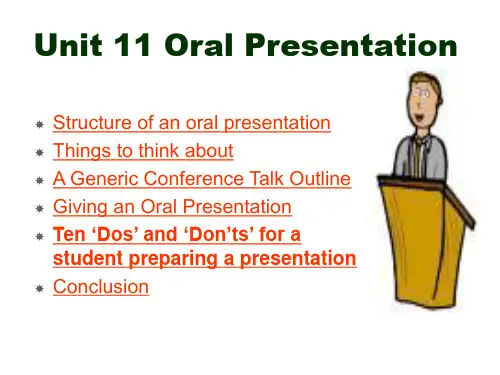
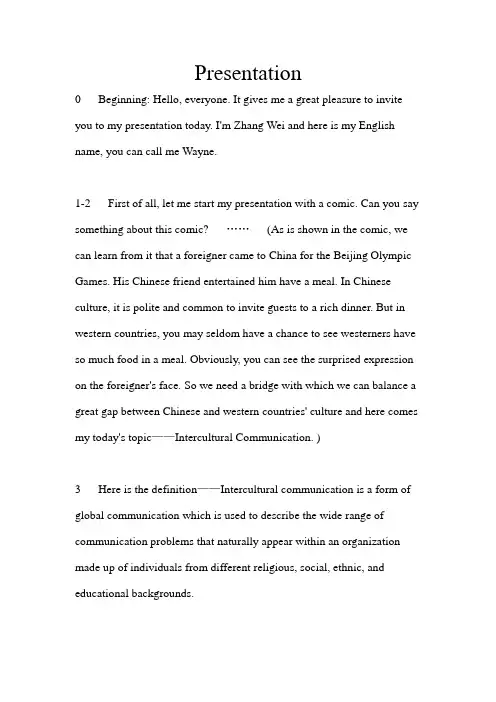
Presentation0 Beginning: Hello, everyone. It gives me a great pleasure to invite you to my presentation today. I'm Zhang Wei and here is my English name, you can call me Wayne.1-2 First of all, let me start my presentation with a comic. Can you say something about this comic? ……(As is shown in the comic, we can learn from it that a foreigner came to China for the Beijing Olympic Games. His Chinese friend entertained him have a meal. In Chinese culture, it is polite and common to invite guests to a rich dinner. But in western countries, you may seldom have a chance to see westerners have so much food in a meal. Obviously, you can see the surprised expression on the foreigner's face. So we need a bridge with which we can balance a great gap between Chinese and western countries' culture and here comes my today's topic——Intercultural Communication. )3 Here is the definition——Intercultural communication is a form of global communication which is used to describe the wide range of communication problems that naturally appear within an organization made up of individuals from different religious, social, ethnic, and educational backgrounds.4-5 Then comes my first question——Could you give any more examples about the different cultures between China and western countries? ……Next I'll show you 12 pictures about it.(1)The first picture is about the different ways of raising advice. Chinese usually raise their advice in a roundabout way while westerners come straight to the point.(2)The second picture is about the different ways of tackling problems. You can see Chinese usually avoid difficulties they will meet but westerners are willing to face a difficulty without any hesitation.(3)From the third picture we can learn that when westerners take a trip, they often use their eye to enjoy the beautiful scene in their trip. But what we Chinese do? We just take a photo aimlessly and quickly return to the coach.(4)(To be continued……)6 If we are exposed to a new environment, we may find it difficult to adapt ourselves because Westerners behave differently from us. Culture is like the water a fish swims in. Once we are suddenly transplanted abroad, we probably become 'like a fish out of water' We may suffer from a related disease——Cultural Shock.7 Here is the explanation of Cultural Shock. Cultural Shock is anexperience of anxiety,worries, displeasure etc. that arise when people enter a new cultural context. It includes four phases: Honeymoon phase, Negotiation phase, Adjustment phase and Mastery phase.8 Then my second question comes: How can we do to get over culture shock as quick as possible? ……(1) To get to know the people of the host country. For this purpose, we must, first of all, learn its language. When we are able to talk with the native of the natives of the host country, we will be confident and a whole new world of cultural meaning will open up for us.(2) Then we must try to find out the value and interest pattern of the native people. In this way, we can find it quite easy to get people to talk to us and be interest in us.(3) Thirdly, we can join the activities of the people, whether it is a carnival, a religious ritual, or some economic activity.9-10 Let's return to International Communication.We can divide it into two parts: culture and communication. You know culture is a set of shared perceptions followed by a large group of people. When we enter a strange environment we need communicate with local people and what we must pay close attention is nine ingredients of communication: Source, Encoding, Channel, Receiver, Decoding, Receiver Response, Feedbackand Noise. Encoding and decoding are of great significance to successful communication. For example,"U R a sexy girl"11 Ending: I think Intercultural Communication is a good way to know about different cultures around the world. Maybe it is not easy to adapt to a new environment. But as long as we have patience to overcome it. What we will gain is not only an enjoyment that a new environment will bring us, but also paving our way to success.。
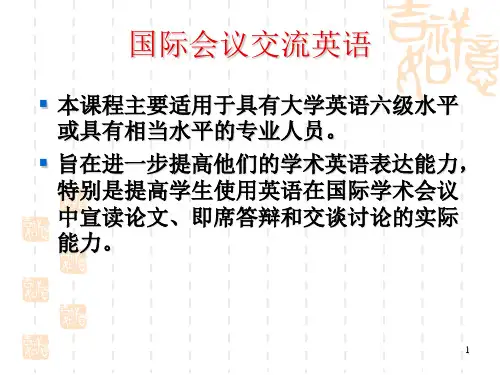
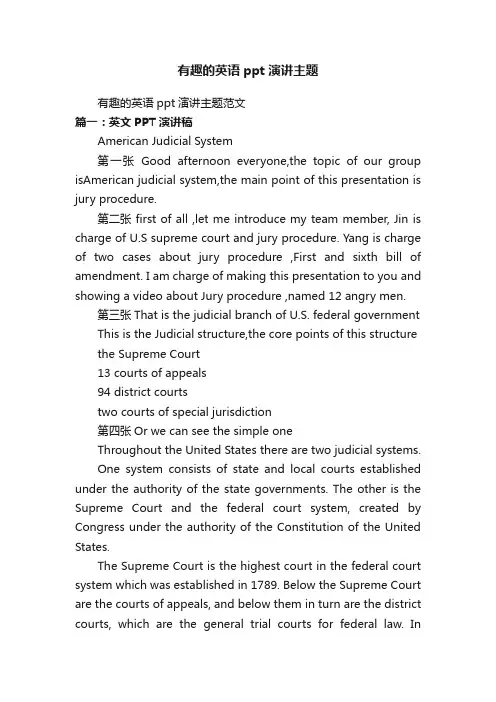
有趣的英语ppt演讲主题有趣的英语ppt演讲主题范文篇一:英文PPT演讲稿American Judicial System第一张Good afternoon everyone,the topic of our group isAmerican judicial system,the main point of this presentation is jury procedure.第二张 first of all ,let me introduce my team member, Jin is charge of U.S supreme court and jury procedure. Yang is charge of two cases about jury procedure ,First and sixth bill of amendment. I am charge of making this presentation to you and showing a video about Jury procedure ,named 12 angry men.第三张That is the judicial branch of U.S. federal government This is the Judicial structure,the core points of this structure the Supreme Court13 courts of appeals94 district courtstwo courts of special jurisdiction第四张Or we can see the simple oneThroughout the United States there are two judicial systems.One system consists of state and local courts established under the authority of the state governments. The other is the Supreme Court and the federal court system, created by Congress under the authority of the Constitution of the United States.The Supreme Court is the highest court in the federal court system which was established in 1789. Below the Supreme Court are the courts of appeals, and below them in turn are the district courts, which are the general trial courts for federal law. Inaddition ,there are two courts of special jurisdictionNext main point is about The American Jury systemAbout O.J.Simpson's caseBefore 1994, NFL football player O. J. Simpson murder case become was America's most sensational events. The case was the trial of twists and turns, O.J. Simpson with a knife to kill his ex-wife and restaurant waiter Ron Gorman two counts of first-degree murder crime refers to control, due to the police a few blunders caused strong evidence of the failure, to acquitted, only to be civil judged to be responsible for the death of two people. The case has also become the history of the United States suspected crimes innocence of the biggest caseThe Role of Jury TrialsIn most common law jurisdictions, the jury is responsible for finding the facts of the case, while the judge determines the law. These "peers of the accused" are responsible for listening to a dispute, evaluating the evidence presented, deciding on the facts, and making a decision in accordance with the rules of law and their jury instructions. Typically, the jury only judges guilt or a verdict of not guilty, but the actual penalty is set by the judge.In the United States, because jury trials tend to be high profile, the general public tends to overestimate the frequency of jury trials. Approximately 150,000 jury trials are conducted in state courts in the U.S., and an additional 5,000 jury trials are conducted in federal courts. Two-thirds of jury trials are criminal trials, while one-third are civil and "other" (e.g., family, municipal ordinance, traffic). Nevertheless, the vast majority of cases are in fact settled by plea bargain, which removes the need for a jury trial.The plot of12 Angry Men revolves around the murder trail ofa Latino boy who is accused of killing his father.The conviction of the boy would mean a death sentence and the destiny of the boy's life is in the hands of twelve male jurors of ranging personalities.The case seems open and shut with a murder weapon and several witnesses to place the boy at the scene of the crime.For eleven of the jurors the decision is apparent that the boy is guilty but for one juror,Mr.Davis (Hey Fonda),the boy's life should entail some discussion to eliminate any reasonable doubt the jurors may have.As the film progresses the personalities of the jurors become apparent and many underlying issues influence the guilty decision chosen by the majority of the jurors.The underlying issues are the complexity of the personalities of the jurors and the reasons why they have the motivation to feel and act the way they do.As the case unfolds further,more is learned about each juror individually.The personalities range from being a short-tempered loud mouth to a straight- laced accountant who never breaks a sweat.As the movie progresses much more is learned of the characters that exposes the intricacy of human nature and people's different personality traits.This film is an excellent example of movie making that does not require elaborate sets to entertain the viewer.The majority of the film takes place in a jury room with the men never leaving the room from their deliberation responsibilities.The cast and dialogue make this film memorable and the film has some clear moral issues that are addressed.The main issue is that not everything is as it seems.With further analysis the understanding of a situation becomes more concrete enabling the men to make a solid decision that affects a young man's life.12 Angry Men is a classic film that should not be missed.From what have been discussed above, we can safely draw the conclusion that the American jury system have the two-sided , but anything existing must be reasonable .Thank you for your attention.篇二:PPT英文演讲稿good morning, everyone!(第一页ppt)i’m honored to be here to make a presentation about translation, together with my partners: 杨英坤 and 袁银梅.(第五页)after a brief introduction, let’s get back to our text book and focus on some details.today, we’re going to learn the following 8 units: i will introduce the first one and leave the rest to my partners.(第六页)the first unit is about word translation method,it includes 3 parts :choice of word extension of wordconversion of word.(第七页)firstly we can discuss choice of wordthe first point : according to the word category we can choose and determine the meaninglet`s see the following 2 examples,the first sentence: in general, the tests work most effectively when the qualities to be measured can be most precisely defined . this sentence means一般来说,当所要测定的特征能够精确界定时,测试效果最佳(第八页)the 2 sentence :in this sentence the definite article modifies work ,so work is noun considering piece together matches work,and work cant be together, we can define work as 工作成果(第九页)the second point :determine the word meaning based on the collocation english and chinese languages havetheir respective collocation relations . the same word for different idioms, expresses different ideas. so ,in english chinese translation, we should deal with english idioms or collocation by chinese collocation .,and then determine the correct translation for example this word hot .it has various meaning . but in particular collocation the word meaning is very clear (第十页)extension of wordwe directly analyze the following two examplesthe first example :elegant systems should be translated into 完美的体系,not 优雅的体系,this point belongs to “replace the word meaning” in a sentence some words from dictionary meaning can make the translation obscure,ambiguous, or even misleading .therefore we need logic context relationships to determine the word meaning the second example:in this sentence offend means 排污超标this point belongs to specify the word meaningaccording to chinese habit, the original meaning of the general and abstract words, express more clear and specific (第十一页)finally we analyze conversation of word。
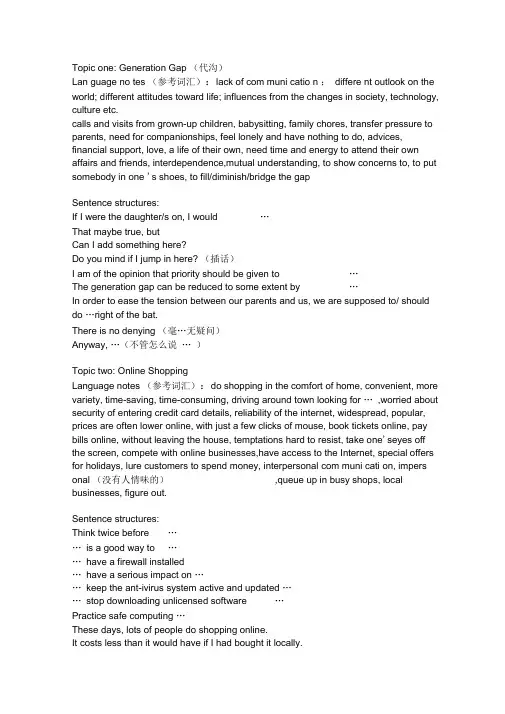
Topic one: Generation Gap (代沟)Lan guage no tes (参考词汇):lack of com muni catio n ;differe nt outlook on the world; different attitudes toward life; influences from the changes in society, technology, culture etc.calls and visits from grown-up children, babysitting, family chores, transfer pressure to parents, need for companionships, feel lonely and have nothing to do, advices, financial support, love, a life of their own, need time and energy to attend their own affairs and friends, interdependence,mutual understanding, to show concerns to, to put somebody in one 's shoes, to fill/diminish/bridge the gapSentence structures:If I were the daughter/s on, I would …That maybe true, butCan I add something here?Do you mind if I jump in here? (插话)I am of the opinion that priority should be given to …The generation gap can be reduced to some extent by …In order to ease the tension between our parents and us, we are supposed to/ should do …right of the bat.There is no denying (毫…无疑问)Anyway, …(不管怎么说… )Topic two: Online ShoppingLanguage notes (参考词汇):do shopping in the comfort of home, convenient, more variety, time-saving, time-consuming, driving around town looking for … ,worried about security of entering credit card details, reliability of the internet, widespread, popular, prices are often lower online, with just a few clicks of mouse, book tickets online, pay bills online, without leaving the house, temptations hard to resist, take one'seyes off the screen, compete with online businesses,have access to the Internet, special offers for holidays, lure customers to spend money, interpersonal com muni cati on, impers onal (没有人情味的),queue up in busy shops, local businesses, figure out.Sentence structures:Think twice before …… is a good way to …… have a firewall installed… have a serious impact on …… keep the ant-ivirus system active and updated …… stop downloading unlicensed software …Practice safe computing …These days, lots of people do shopping online.It costs less than it would have if I had bought it locally.What's going to happen to our local business?esBut it 's so much quicker and easier to shop around on thrneeItn.teI am sure you ' re right, but I ' d rather support •…,even if it •… Topic Three: Planning to Live AbroadLanguage Notes:The good of living abroad: save money, enjoy life there, beautiful house, nice natural environment, a chance to mingle with new cultures, look into history, make friends from different countries, good quality of life, earns more, better lifestyle, language flue ncy, travelli ng widely, broade n horiz on, great cultural aware ness •…The bad of living abroad: cultural shock, language barriers, missing friends and family, quality of life falls, housing problem, shopping, transportation, other services, expensive, lack of convenient supermarkets, be treated with scorn and taunt, racial discrimination, homesickness,toil and hardships in part-time jobs, discouragement, anger.Sentence Structures:It may be true that …It would be un wise to …You would be at a disadvantage if …It is ridiculous to say …Things like … might happen, but …It is unbelievable that …I have heard that …It has been my expeirence that …Is it true that …?Should I …?What can I do if …?Is it necessary for me …?Must I …?If I were you, I would …I think it might be better if you …I 'd suggest that you …I think you 'd better …I still experience shock after …Get used to ….Adjust myself to the things there.Topic Four: Violence in SportsLanguage Notes:French midfielder Zidane head-butt Italian defender Materazzi in 2006 World Cup Final, astonish, audience, irresponsible, sense of responsibility, reflection, on behalf of,phenomenon, demonstrate, indicate, positive energy, live up to the expectations of fall victim to sports violenee, ban (禁赛),be vulnerable to, amateur (业余球员),mini mize, injury, professi on al, suffer from, den tal problems 打坏牙齿),damage to internal organ(损伤内脏),be more likely to, strength, skill, will power (意志力),appeal to (呼吁),numerous (不计其数的),commercial hit (商业卖点),safety mon itori ng (安全监督),health in sura nee, barbaric (野蛮的),safety measures, protective equipment, game rules, boxing, boxers, down and out, tactics (战术), death rate, fascinating奇妙的),suspensions?赛、points deduetions扣分,exelusions 取消参赛资格,disciplinary code纪律准则Sentence structures:Sport is beautiful, violence is not.Violence just causes pain, too much pain.What about violence in football?This is a reflection of the violence in society at large. 是社会总体暴力现象的一个反映Pour petrol on the flames 火上浇油It is unfortun ate that we …Financial fines are not sufficient.Football is sometimes in danger of being taken hostage by this violence.I hope the deaths in boxing matches can bring about some effective changes.Topic Five: Human and AnimalsLanguage Notes:Souls of animals, humans, fellow creatures, animal-hunting, animal welfare, sentimental, emotions, equal rights, elephant tusks, hunting dolphins, a heavy heart, feel sorry for, companions, devotion, loyalty, unconditional love, bring tears to my eyes, live and let live, be free to do what they like …Sentence structures:We should care for animal welfare.Bullfight is barbaric, not justified as sports.Be devoted to increasing public awareness of animal protection.Use psychology and education to enrich the world through respect for non-human animals.Reveal animal experimentation crueltyProtest the violence of factory farms and slaughterhousesReport animal abuseEducate society the rights of all non-human animals.Educate people about animal abuseExplore our relationship with animals through cultural, history and philosophy.Provide small grants / money for grassroots animal advocacyProvide assistance to sick, injured and homeless animals.Vegetarian solutions: changing the world one meal at a time, for your health, for the animals, for the environment.Animal defense: work to abolish the fur trade.Promote a lifestyle that is free from animal products.Be against animal testing.Topic Six: Farmers ' WorriesLanguage notes: fertilizer 肥料,chemical fertilizer 化肥,terrace梯田,erosion侵蚀,barter物物交换,drought 干旱,poor soil 土壤贫瘠,flood, insufficient irrigation 灌溉不足,plague of in sects and pest病虫害,good years and bad on丰年和歉收, good salaries 开高工资,advanced education, new kinds of entertainment, farm subsidies 农业补贴,household con tract 包产至U户,resp on sibility system 责任制,extra funds 额外投入,reform of rural taxes and admi nistrative charges 农业税费的改革,non-profit education programs, needy families 困难户,caring environment 营造关心农业的大环境,forestry林业,animal husbandry畜牧业,fishery渔业,primary/secondary/tertiary industries第一、二、三产业,eliminate differences between rural regions and urban cities 消除城乡差别,promoting the integration of rural regions and cities 促进城乡融合,short-term gain 短期利益,Iong-term pain 长期问题,Sentence structures:Offer assistance to the needyCare for othersGrassroots-level society Non-profit programs Contribute to A sense of fulfillment The land is small, and no longer fertile, bleeding year after year. The soil is difficult to till in a bad yearFarmers are reluctant to invest in the land they currently hold.Famers in coastal provinces take jobs in cities but still need to pay taxes and fees for their contracted land.The chemicals from fertilizers may cause water pollution.Excessive use of chemical fertilizers may…Topic Seven: Sense of HumorLanguage Notes: humorous, knowledgeable, learned, relaxing, not frightening, interesting, dull, boring, concentrate, vary from person to person, as far as I am concerned, the most essential quality of being a good partner, a perfect example, funny, amusing, humoristic, facetious, glad, joyful, laughing, pleased, cheerful, sense of humor, non-critical, enhance, comedy, funny, an outburst of laughterSentence structures:Pers on ally speak in g,…If I am asked, I will …I think / agree that…I can not agree more…Humor doesn'simply invo Ive …,it in eludes …A good sense of humor will help me …We enhance our sense of humor by/ in the way o…Not exactly.There are many levels of humor.Humor often results in laughter.Positive laughter has the potential to enhance the health of individual students and group cohesion.Topic Eight: Today 's workplaceLanguage notes: downturn in the economy, cut back on production, lay off, stick with current company, figure out what to do, get passed over for a promotion, hand in notice, give up, equal treatment, come up with, catch on, sales take off, get ahead in one's career, little chance of, in places, think of, why bother, goof off, claim, go for, work extra hard, glass ceiling of personal development, specialize in, an opportunity in disguise, butterflies in one s stom'ach, so to speak, lead to, be open to, turn over, can't stand, thrill, come around, tour guide, yoga instructor,Sentence Structures:Bear in mind that …I can agree to that -That will be fine.If you will, I would …I am afraid I can'. tWhy would you quit your job as …I am sure you'll do great.What I 'e been thinking about is that…Perhaps you could…That can be an option.It will pay off in the long run.I know what you are saying, but what I am trying to getis that …Topic Nine: Are You A Savvy SaverLanguage notes: reward oneself, see sth. as a priority, settle down, lead an extravagant lifestyle, by any means, splurge on ,squander, make ends meet, put away, invest, live paycheck to paycheck, watch, sensible things, stick to a budget, get out of debt, run out of money, max out, get finances in order, pay off., cut back on, doable, come out to, anxiety attackSentence Structures:I live paycheck to paycheck and have to watch how I spend money.I really have to budget to make ends meet.Saving money is not really a priority for now.My money usually goes to sen sible things like…Sticking to a budget can be tough. Someday money will run out.Why don 'you …From looking at your expenses,I 'd agree with you there.Well, the first thing to do, I think is to eliminate …But if we don'tget things under control, we are going to be in big trouble.Let'stake one step at a time and see if we can-That'seasier said than done.I guess I can accept that.I think it 'm s ore like 60 dollars per month.And what about magazine subscriptions?This is the way we need to look at it.I 'dsuggest taking your own coffee from home.Hold on a second.Topic Ten: the disappearance of the Boss 's Birthday CakeLanguage notes: mysterious disappearance, fridge, cleaners, suspect, thief, celebrate, convince, evidence, track down, traces, fingerprints, work schedule, vacuum cleaner, noise, cover, doubt, on one'sway to work, can'tbelieve my eyes, out of the ordinary, once in a hundred year, right on the spot, investigation, questioning, tight, lock, backup plan/ plan B, can't do without, wonder, surveillance camera, security pers onn el, theory,…Sentence Structures:I won der if …I suppose…I suspect …I am pretty sure that …I am convinced that …It 'impossible …There's no doubt that…How come…?怎么会No way!That hardly seems likely.Well, maybe, but…Perhaps we should…。
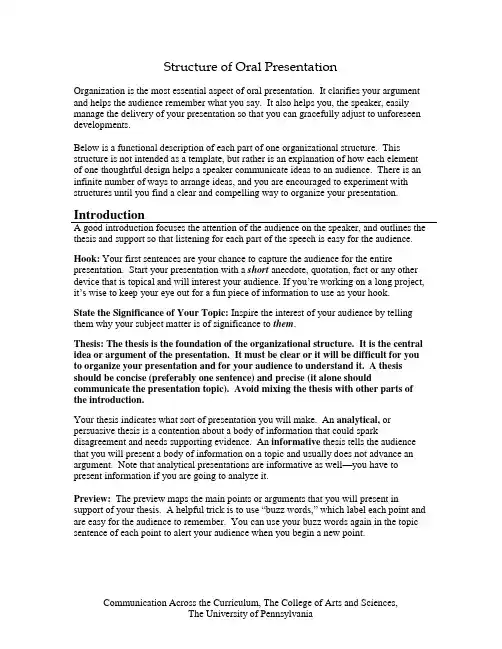
Structure of Oral PresentationOrganization is the most essential aspect of oral presentation. It clarifies your argument and helps the audience remember what you say. It also helps you, the speaker, easily manage the delivery of your presentation so that you can gracefully adjust to unforeseen developments.Below is a functional description of each part of one organizational structure. This structure is not intended as a template, but rather is an explanation of how each element of one thoughtful design helps a speaker communicate ideas to an audience. There is an infinite number of ways to arrange ideas, and you are encouraged to experiment with structures until you find a clear and compelling way to organize your presentation. IntroductionA good introduction focuses the attention of the audience on the speaker, and outlines the thesis and support so that listening for each part of the speech is easy for the audience. Hook: Your first sentences are your chance to capture the audience for the entire presentation. Start your presentation with a short anecdote, quotation, fact or any other device that is topical and will interest your audience. If you’re working on a long project, it’s wise to keep your eye out for a fun piece of information to u se as your hook.State the Significance of Your Topic: Inspire the interest of your audience by telling them why your subject matter is of significance to them.Thesis: The thesis is the foundation of the organizational structure. It is the central idea or argument of the presentation. It must be clear or it will be difficult for you to organize your presentation and for your audience to understand it. A thesis should be concise (preferably one sentence) and precise (it alone should communicate the presentation topic). Avoid mixing the thesis with other parts of the introduction.Your thesis indicates what sort of presentation you will make. An analytical, or persuasive thesis is a contention about a body of information that could spark disagreement and needs supporting evidence. An informative thesis tells the audience that you will present a body of information on a topic and usually does not advance an argument. Note that analytical presentations are informative as well—you have to present information if you are going to analyze it.Preview: The preview maps the main points or arguments that you will present in support of your thesis. A helpful trick is to use “buzz words,” which label each point and are easy for the audience to remember. You can use your buzz words again in the topic sentence of each point to alert your audience when you begin a new point.BodyThe body of your speech presents claims and evidence in support of your thesis. It should be broken into several central points, each of which may have sub-points. Determine how to arrange your points based on how you believe your argument or information is best conceptualized. In addition to structuring the body, structure each point internally. Basic structural suggestions for points follow:Topic Sentence: The topic sentence introduces the major arguments or claims supporting the thesis in an analytical speech and the topic of each point in an informative speech. Unfortunately you don’t have the opportunity to highlight you r topic sentence visually with an indented line as you would if you were starting a paragraph, but you can mark it orally by including the buzz words you created in the preview or by signposting (see page 3 for an discussion of signposting). Hint: most people are inclined to put the topic sentence at the end of a point so most speakers must be vigilant about this habit.Preview: Preview sub-points if you have them.Present Evidence: Present (and cite!) information from external sources.Clarify Evidence: Provide an explanation of your evidence so that the audience can understand and evaluate it. When presenting a graph, explain what each axis represents and highlight important conclusions or relationships in the data.Warrant: It isn’t always cle ar to the audience that your evidence can legitimately support your claim. Warrants clarify and justify your claim by providing a rationale for why conclusions made from your evidence are valid. For example, to make the claim, “CEO Anita is guilty of defrauding investors” based on evidence,“Anita accounted for significant company losses in a later accounting period than the one in which they were first apparent,” you need the warrant, “CEO’s who account for losses in a period later than the period in whi ch they were first apparent are guilty of fraud.” Note that the warrant, like the claim, is not absolute and could be changed.Transition: Transitions help you balance the need to break your presentation into sections with the need to convey the interdependent nature of your ideas. Signal a transition between points by explaining how one point relates to the next.ConclusionReview: Remind your audience of the arguments you made in support of your thesis by restating them, again using the buzzwords of your preview and topic sentences.Restate Your Thesis: Follow the review with a restatement of your thesis so that the audience is left with a clear understanding of how your evidence supports your thesis.Conclusion: Your conclusion should give the audience a sense of closure. You might return to your “hook,” pose questions for further discussion, or suggest future inquiries that would further illuminate the topic.More Helpful Organizational Devices:Signposts: Signposts explicitly highlight the presentation’s organization and major ideas for the audience by using marking words (first, next, last, in sum, therefore etc.) or entire phrases (The most important thing to understand about X is…).Internal Summaries: Highlight and clarify the most important conclusions of complex sections of your presentation by summarizing them at the end of the section. Consistent Vocabulary: Use the same word each time you refer to a particular concept. If you use synonymous words or phrases when referring to the same concept, some members of the audience may think you are introducing a new and different concept. Likewise, highlight subtle differences between concepts by using different vocabulary when speaking about them. “Buzz words,” above under “preview,” and “repetition,” discussed below, are variations on this device.Repetition: In this design the preview and review echo each other and the topic sentences and transitions repeat parts of the preview throughout the presentation. This repetition allows people to learn how your presentation, and your ideas, are structured and helps them remember what you said. Repetition is emphasized more in speech than in writing because in speech the audience has little ability to control the speed of the presentation to match their rate of comprehension, and they can not back-loop (meaning re-read sections).Relate Each Point Back to Your Thesis: A common mistake is to state the thesis at the beginning and then proceed without making its presence clear in the rest of the presentation. Individuals in the audience may or may not be able to maintain your thesis in memory and discern how your presentation is supporting it. If you restate your thesis periodically by explaining how each point supports the thesis, your presentation will have unity and people will understand how your ideas work together to support your thesis. (You may have noticed that this device is a variant of repetition).Rate: If you think parts of your presentation will be difficult for your audience to assimilate, you should consider slowing the rate of your delivery or even pausing to let information sink in before you continue. You should also be aware of signals of confusion from the audience and should stop to clarify sections of your presentatio n where necessary. In most situations, it is appropriate to ask the audience whether they need clarification when you are not sure whether they understand a concept.Primacy and Recency: Audiences most easily remember what they hear first and last. You might take advantage of this effect by putting your best points or sub-points first or last. However, it is most important that you build your argument in a logical and sensible way, so you will often find that this organizational consideration is irrelevant.。
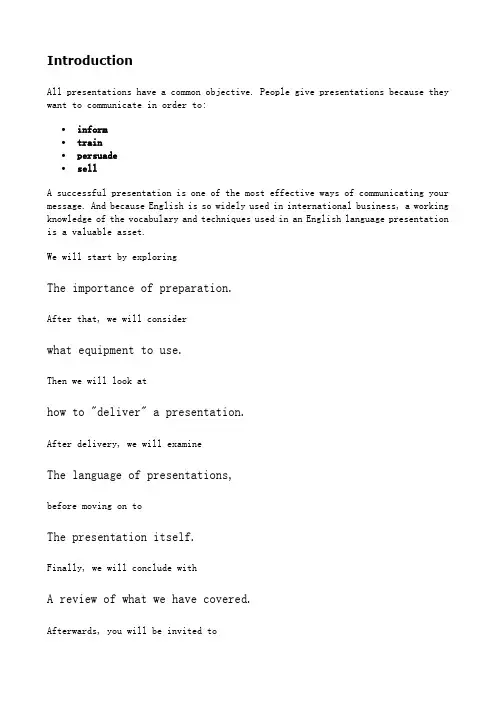
IntroductionAll presentations have a common objective. People give presentations because they want to communicate in order to:∙inform∙train∙persuade∙sellA successful presentation is one of the most effective ways of communicating your message. And because English is so widely used in international business, a working knowledge of the vocabulary and techniques used in an English language presentation is a valuable asset.We will start by exploringThe importance of preparation.After that, we will considerwhat equipment to use.Then we will look athow to "deliver" a presentation.After delivery, we will examineThe language of presentations,before moving on toThe presentation itself.Finally, we will conclude withA review of what we have covered.Afterwards, you will be invited totake a test and ask questions.PreparationCan you name the 3 most important things when giving any presentation?Number 1 is . . .PreparationNumber 2 is . . .Preparation!Number 3 is . . .Preparation!!Preparation is everything!With good preparation and planning you will be totally confident and less nervous. And your audience will feel your confidence. Your audience, too, will be confident. They will be confident in you. And this will give you control. Control of your audience and of your presentation. With control, you will be 'in charge' and your audience will listen positively to your message.ObjectiveBefore you start to prepare a presentation, you should ask yourself: "Why am I making this presentation?" Do you need to inform, to persuade, to train or to sell? Your objective should be clear in your mind. If it is not clear in your mind, it cannot possibly be clear to your audience.Audience"Who am I making this presentation to?" Sometimes this will be obvious, but not always. You should try to inform yourself. How many people? Who are they? Business people? Professional people? Political people? Experts or non-experts? Will it be a small, intimate group of 4 colleagues or a large gathering of 400 competitors? How much do they know already and what will they expect from you?Venue"Where am I making this presentation?" In a small hotel meeting-room or a large conference hall? What facilities and equipment are available? What are the seating arrangements?Time and length"When am I making this presentation and how long will it be?" Will it be 5 minutes or 1 hour? Just before lunch, when your audience will be hungry, or just after lunch, when your audience will be sleepy?MethodHow should I make this presentation?" What approach should you use? Formal or informal? Lots of visual aids or only a few? Will you include some anecdotes and humour for variety?Content"What should I say?" Now you must decide exactly what you want to say. First, you should brainstorm your ideas. You will no doubt discover many ideas that you want to include in your presentation. But you must be selective. You should include only information that is relevant to your audience and your objective. You should exclude all other ideas. You also need to create a title for your presentation (if you have not already been given a title). The title will help you to focus on the subject. And you will prepare your visual aids, if you have decided to use them. But remember, in general, less is better than more (a little is better than a lot). You can always give additional information during the questions after the presentation.StructureA well organised presentation with a clear structure is easier for the audience to follow. It is therefore more effective. You should organise the points you wish to make in a logical order. Most presentations are organised in three parts, followed by questions:NotesWhen you give your presentation, you should be - or appear to be - as spontaneous as possible. You should not read your presentation! You should be so familiar with your subject and with the information that you want to deliver that you do not need to read a text. Reading a text is boring! Reading a text will make your audience go to sleep! So if you don't have a text to read, how can you remember to say everything you need to say? With notes. You can create your own system of notes. Some people make notes on small, A6 cards. Some people write down just the title of each section of their talk. Some people write down keywords to remind them. The notes will give you confidence, but because you will have prepared your presentation fully, you may not even need them!RehearsalRehearsal is a vital part of preparation. You should leave time to practise your presentation two or three times. This will have the following benefits:∙you will become more familiar with what you want to say∙you will identify weaknesses in your presentation∙you will be able to practise difficult pronunciations∙you will be able to check the time that your presentation takes and make any necessary modificationsSo prepare, prepare, prepare! Prepare everything: words, visual aids, timing, equipment. Rehearse your presentation several times and time it. Is it the right length? Are you completely familiar with all your illustrations? Are they in the right order? Do you know who the audience is? How many people? How will you answer difficult questions? Do you know the room? Are you confident about the equipment? When you have answered all these questions, you will be a confident, enthusiastic presenter ready to communicate the subject of your presentation to an eager audience.EquipmentEasily your most important piece of equipment is...YOU! Make sure you're in full working order, and check your personal presentation carefully - if you don't, your audience will!The overhead projector (OHP) displays overheadtransparencies(OHTs or OHPTs). It has several advantagesover the 35mm slide projector:∙it can be used in daylight∙the user can face the audience∙the user can write or draw directly on thetransparency while in useThe whiteboard(more rarely blackboard or greenboard) is a usefuldevice for spontaneous writing - as in brainstorming, for example.For prepared material, the OHP might be more suitable.The duster is used for cleaning the whiteboard. It is essential thatthe duster be clean to start with. You may consider carrying your ownduster just in case.Markers are used for writing on the whiteboard (delible - you canremove the ink) or flipchart (indelible - you cannot remove the ink).They are usually available in blue, red, black and green. Again, it's a good idea to carry a spare set of markers in case you are given some used ones which do not write well."A good workman never blames his tools."The flipchart consists of several leaves of paper that you 'flip' or turnover. Some people prefer the flipchart to the whiteboard, but its use islimited to smaller presentations.The Slide projector - which must be used in adarkened room - adds a certain drama. Some slideprojectors can be synchronised with audio foraudio-visual (AV) presentations. These projectorsare typically used for larger presentations. Themajority take 35mm slides or transparencies (as seen here), but projectors for 6x6cm slides are also available.Transparencies are projected by an overhead projector or a slideprojector onto a screen - in this case a folding screen which can bepacked up and transported.The notebook computer is increasingly being used to display graphicsduring presentations. It is often used in conjunction with an overheadprojector, which actually projects the image from the computer screenonto the wall screen.Handouts are any documents or samples that you 'hand out' or distributeto your audience. Note that it is not usually a good idea to distributehandouts before your presentation. The audience will read the handoutsinstead of listening to you.Delivery'Delivery' refers to the way in which you actually deliver or perform or give your presentation. Delivery is a vital aspect of all presentations. Delivery is at leastas important as content, especially in a multi-cultural context.NervesMost speakers are a little nervous at the beginning of a presentation. So it is normal if you are nervous. The answer is to pay special attention to the beginning of your presentation. First impressions count. This is the time when you establish a rapport with your audience. During this time, try to speak slowly and calmly. You should perhaps learn your introduction by heart. After a few moments, you will relax and gain confidence.Audience RapportYou need to build a warm and friendly relationship with your audience. Enthusiasm is contagious. If you are enthusiastic your audience will be enthusiastic too. And be careful to establish eye contact with each member of your audience. Each person should feel that you are speaking directly to him or her. This means that you must look at each person in turn - in as natural a way as possible. This will also give you the opportunity to detect signs of boredom, disinterest or even disagreement, allowing you to modify your presentation as appropriate.Your objective is to communicate!Body LanguageWhat you do not say is at least as important as what you do say. Your body is speaking to your audience even before you open your mouth. Your clothes, your walk, your glasses, your haircut, your expression - it is from these that your audience forms its first impression as you enter the room. Generally speaking, it is better to stand rather than sit when making a presentation. Be aware of and avoid any repetitive and irritating gestures. Be aware, too, that the movement of your body is one of your methods of control. When you move to or from the whiteboard, for example, you can move fast or slowly, raising or reducing the dynamism within the audience. You can stand very still while talking or you can stroll from side to side. What effect do you think these two different approaches would have on an audience?Cultural ConsiderationsBecause English is so widely used around the world, it is quite possible that many members of your audience will not be native English-speakers. In other words, they will not have an Anglo-Saxon culture. Even within the Anglo-Saxon world, there are many differences in culture. If we hypothetically imagine a German working for an Israeli company making a presentation in English to a Japanese audience in Korea,we can see that there are even more possibilities for cultural misunderstanding. You should try to learn about any particular cultural matters that may affect your audience. This is one reason why preparation for your presentation is so important. Cultural differences can also be seen in body language, which we have just discussed. To a Latin from Southern France or Italy, a presenter who uses his hands and arms when speaking may seem dynamic and friendly. To an Englishman, the same presenter may seem unsure of his words and lacking in self-confidence.Voice qualityIt is, of course, important that your audience be able to hear you clearly throughout your presentation. Remember that if you turn away from your audience, for example towards the whiteboard, you need to speak a little more loudly. In general, you should try to vary your voice. Your voice will then be more interesting for your audience. You can vary your voice in at least three ways:∙speed: you can speak at normal speed, you can speak faster, you can speak more slowly - and you can stop completely! You can pause. This is a very goodtechnique for gaining your audience's attention.∙intonation: you can change the pitch of your voice. You can speak in a high tone. You can speak in a low tone.∙volume: you can speak at normal volume, you can speak loudly and you can speak quietly. Lowering your voice and speaking quietly can again attract youraudience's interest.The important point is not to speak in the same, flat, monotonous voice throughout your presentation - this is the voice that hypnotists use to put their patients' into trance!Visual aidsOf all the information that enters our brains, the vast majority of it enters through the eyes. 80% of what your audience learn during your presentation is learned visually (what they see) and only 20% is learned aurally (what they hear). The significance of this is obvious:∙visual aids are an extremely effective means of communication∙non-native English speakers need not worry so much about spoken English - they can rely more heavily on visual aidsIt is well worth spending time in the creation of good visual aids. But it is equally important not to overload your audience's brains. Keep the information on each visual aid to a minimum - and give your audience time to look at and absorb this information. Remember, your audience have never seen these visual aids before. They need time to study and to understand them. Without understanding there is no communication.Apart from photographs and drawings, some of the most useful visual aids are charts and graphs, like the 3-dimensional ones shown here:Piecharts are circular in shape (like a pie).Barcharts can be vertical (as here) or horizontal.Graphs can rise and fall.Audience ReactionRemain calm and polite if you receive difficult or even hostile questions during your presentation. If you receive particularly awkward questions, you might suggest that the questioners ask their questions after your presentation.LanguageSay what you are going to say,Simplicity and ClarityIf you want your audience to understand your message, your language must be simple and clear.Use short words and short sentences.Do not use jargon, unless you are certain that your audience understands it.In general, talk about concrete facts rather than abstract ideas.Use active verbs instead of passive verbs. Active verbs are much easier to understand. They are much more powerful. Consider these two sentences, which say the same thing:1.Toyota sold two million cars last year.2.Two million cars were sold by Toyota last year.Which is easier to understand? Which is more immediate? Which is more powerful? N°1 is active and N°2 is passive.SignpostingWhen you drive on the roads, you know where you are on those roads. Each road has a name or number. Each town has a name. And each house has a number. If you are at house N° 100, you can go back to N° 50 or forward to N° 150. You can look at the signposts for directions. And you can look at your atlas for the structure of the roads in detail. In other words, it is easy to navigate the roads. You cannot get lost. But when you give a presentation, how can your audience know where they are? How can they know the structure of your presentation? How can they know what is coming next? They know because you tell them. Because you put up signposts for them, at the beginning and all along the route. This technique is called 'signposting' (or'signalling').During your introduction, you should tell your audience what the structure of your presentation will be. You might say something like this:"I'll start by describing the current position in Europe. Then I'll move on to some of the achievements we've made in Asia. After that I'll consider the opportunities we see for further expansion in Africa. Lastly, I'll quickly recap before concluding with some recommendations."A member of the audience can now visualize your presentation like this:He will keep this image in his head during the presentation. He may even write it down. And throughout your presentation, you will put up signposts telling him which point you have reached and where you are going now. When you finish Europe and want to start Asia, you might say:"That's all I have to say about Europe. Let's turn now to Asia."When you have finished Africa and want to sum up, you might say:"Well, we've looked at the three continents Europe, Asia and Africa. I'd like to sum up now."And when you finish summing up and want to give your recommendations, you might say:"What does all this mean for us? Well, firstly I recommend..."The table below lists useful expressions that you can use to signpost the various parts of your presentation.The PresentationMost presentations are divided into 3 main parts (+ questions):As a general rule in communication, repetition is valuable. In presentations, there is a golden rule about repetition:1.Say what you are going to say,2.say it,3.then say what you have just said.In other words, use the three parts of your presentation to reinforce your message. In the introduction, you tell your audience what your message is going to be. In the body, you tell your audience your real message. In the conclusion, you summarize what your message was.We will now consider each of these parts in more detail.IntroductionThe introduction is a very important - perhaps the most important - part of your presentation. This is the first impression that your audience have of you. You should concentrate on getting your introduction right. You should use the introduction to:1.welcome your audience2.introduce your subject3.outline the structure of your presentation4.give instructions about questionsThe following table shows examples of language for each of these functions. You may need to modify the language as appropriate.BodyThe body is the 'real' presentation. If the introduction was well prepared and delivered, you will now be 'in control'. You will be relaxed and confident.The body should be well structured, divided up logically, with plenty of carefully spaced visuals.Remember these key points while delivering the body of your presentation: ∙do not hurry∙be enthusiastic∙give time on visuals∙maintain eye contact∙modulate your voice∙look friendly∙keep to your structure∙use your notes∙signpost throughout∙remain polite when dealing with difficult questionsConclusionUse the conclusion to:1.Sum up2.(Give recommendations if appropriate)3.Thank your audience4.Invite questionsThe following table shows examples of language for each of these functions. You may need to modify the language as appropriate.QuestionsQuestions are a good opportunity for you to interact with your audience. It may be helpful for you to try to predict what questions will be asked so that you can prepare your response in advance. You may wish to accept questions at any time during your presentation, or to keep a time for questions after your presentation. Normally, it's your decision, and you should make it clear during the introduction. Be polite with all questioners, even if they ask difficult questions. They are showing interest in what you have to say and they deserve attention. Sometimes you can reformulate aquestion. Or answer the question with another question. Or even ask for comment from the rest of the audience.Review...then say what you have just said.In this seminar, you have learned:∙to allow plenty of time for preparation∙to ask the all-important question-words, why? who? where? when? how? and what?∙to structure your presentation into introduction, body, conclusion and questions∙to write notes based on keywords∙to rehearse your presentation several times and modify it as necessary ∙to select the right equipment for the job∙to use equipment effectively∙to make use of clear, powerful visual aids that do not overload your audience ∙to use clear, simple language, avoiding jargon∙to use active verbs and concrete facts∙to explain the structure of your presentation at the beginning so that your listeners know what to expect∙to link each section of your presentation∙to signpost your presentation from beginning to end so that your listeners know where they are∙to say what you are going to say, say it, and say what you have just said ∙to overcome your nerves∙to establish audience rapport∙to be aware of your body language∙to understand cultural differences∙to control the quality of your voice∙to maintain interest by varying the speed, volume and pitch of your voice ∙to deal with listeners' questions politely∙to respond to your audience positively。
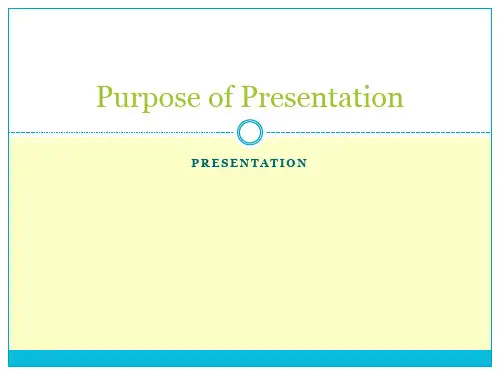
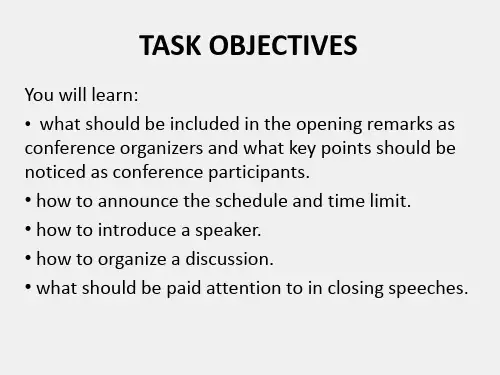
在我们日常工作中,很多时候需要做陈述, 报告和演示, 但大多数时候我们在做Presentation 的时候显的比较紧张,如何克服这种紧张感, 自信而又清晰地表达自己, 从而做出一个有效的的Presentation. Content & Structure , 即内容和结构可以说是最关键的部分。
一个良好的Presentation 主题应当明确, 信息量充足, 并且具有说服力和逻辑性。
结构通常包括开头, 主体, 结语, 条理清晰. 要使用适当的过渡词, 使听众跟上思路。
同时还要注意Pronunciation & Intonation , 即语音语调。
不论使用中文还是外语的Presentation, 现场的语言表达能力都是决定成败的关键。
因此, 这一部分主要评价讲演者的发音是否准确, 语调是否有高低起伏, 声音是否清晰响亮以及有无语法错误等。
下面我们就最基本的Structure 部门进行一个讲解, 常规的Presentation结构一般分为问候,主题,长度,提纲,提问这四个部分. 下面我们列出了各个部分常用的一些句子, 供大家参考使用.1.Greeting, name, positionLadies and gentlemen. It’s an honor to have the opportunity to address such a distinguished audience.Good morning. Let me start by saying just a few words about my own background. I started out in….Good afternoon and thank you for making the effort to be here with us today.Good morning, ladies and gentlemen. It’s a pleasure to be with you today.2.Ttile/SubjectI’d like to talk(to you) about….I’m going to present the recent…explain our position on…brief you on….inform you about…describe…The subject/fo cus/topic of my presentation….We are here today to decide…agree…learn about….The purpose of this talk is to update you onput you in the picture about…give you the background to…3.LengthI shall only take …minutes of your time.I plan to be brief.This should only last …minutes.4.Outline/Main partsI’ve divided my presentation into four parts/sections. They are….The subject can be looked at under the following headings:….We can break this area down into the following fields:First/First of all…Secondly/then/next…Thirdly/a nd then we come to…Finally/lastly/last of all….5.QuestionsI’d be glad to answer any questions at the end of the my talk.If you have any questions, please feel free to interrupt.Please interrupt me if there’s something which needs clarifying. Otherwise, there’ll be time for discussion at the end.做presentation,我们要注意对话题的准备以及态度和身体语言等等,除此之外,我们还应该掌握一些常用句型。
英文提案(presentation)时可以使用的句式做presentation时不用怕了转帖一成功英语演讲的秘诀:开场白、结束语应对问题-I will be pleased to answer anyquestions you may have at the end of the presentation.-Please canyou save your questions till the end.-If you have any questions,I will be pleased to answer them at the end of the presentation.-therewill be time at the end of the presentation to answer your questions-so please feel free to ask me anything then.-Don't hesitate tointerrupt if you have a question.-Please feel free to interrupt meat any time.-Please stop me if you have any questions.-If youneed clarification on any point, you're welcome to ask questions at any time.-Can I come back to that point later?-I will be coming tothat point in a minute.-That's a tricky question.-We will gointo details later. But just to give you an idea of...-I am afraidthere's no easy answer to that one...-Yes, that's a very good point.-Perhapswe could leave that point until the questions at the end of the presentation-I think I said that I would answer questions at the endof the presentation---perhaps you wouldn't mind waiting until then.-Ithink we have time for just one more question欢迎听众(正式)-Welcome to our company- I am pleased to be able to welcome you toour company...- I'd like to thank you for coming.- May I takethis opportunity of thanking you for coming欢迎听众(非正式)- I'mglad you could all get here...- I'm glad to see so many people here.-It's GREat to be back here.- Hello again everybody. Thank you forbeing on time/making the effort to come today.- Welcome to X PartII.受邀请在会议上致词- I am delighted/pleased/glad to have theopportunity to present/of making this presentation...- I am gratefulfor the opportunity to present...- I'd like to thank you forinviting/asking me/giving me the chance to...- Goodmorning/afternoon/evening ladies and gentleman- It's my pleasantduty today to...- I've been asked to...告知演讲的话题- thesubject of my presentation is...- I shall be speaking today about...-My presentation concerns...- Today's topic is...- Today we arehere to give a presentation on...- Today we are here to talkabout...Before we start, I'd like you meet my team members... - Abrief look at today's agenda...(告诉听众所讲内容的先后顺序) - Before we start ourpresentation, let's take a brief look at the agenda...- I shall beoffering a brief analysis of...- the main area that I intend tocover in this presentation is...- Take a moment and think of...-Thank you for giving me the opportunity to tell you about...告诉听众发言的长度- During the next ten minutes, I shall...- I shall bespeaking for about ten minutes...- My presentation will last forabout ten minutes...- I won't take up more than ten minutes of yourtime...- I don't intend to speak for longer than ten minutes...-I know that time is short, so I intend to keep this brief- I have alot to cram in to the next ten minutes, so I'd better make a start...引起听众的兴趣- I'm going to be speaking about something that is vitallyimportant to all of us.- My presentation will help solve a problemthat has puzzled people for years...- At the end of thispresentation you will understand why this company has been so successful for so long...- I am going to be talking about a product that coulddouble your profit margins...- the next ten minutes will changeyour attitude to sales and marketing...- Over the next ten minutesyou are going to hear about something that will change the way your companies operate...- By the end of this presentation you will knowall there is to know about...告诉听众内容要点- there are five mainaspects to this topic (...the first, ... the second, ...a third,...another, ... the final)- I am going to examine these topics inthe following order (...first, ...next, ...after that, ...finally)-I've divided my talk into five parts...- I will deal with thesetopics in chronological order...- I'm going to start with a generaloverview and then focus on this particular problem (...in general, ...more particularly).- I want to start with this particular topic,and then draw some more general conclusions from it (...specifically, ... in a wider context).- there are (a number of) factors that mayaffect...- We have to take into account in any discussion of thissubject, the following considerations.- We all ought to be aware ofthe following points.结束语-In conclusion, I'd like to...-I'dlike to finish by...-Finally...-By way of conclusion...-Ihope I have made myself understood-I hope you have found thisuseful-I hope this has given you some idea/clear idea/an outline of...-Let me end by saying...-That, then was all I had to sayon...-That concludes our presentation...-I hope I've managed togive you a clearer picture of...-If there are any questions, I'd bedelighted to...-Thank you for your attention...-Let's break for acoffee at this point-I am afraid that the clock is against us, sowe had better stop here-You have been a very attentiveaudience---thank you转自/doc/8915450525.html,/abc/html/kouyujicui/20 070821/4.html转帖二做presentation,我们要注意对话题的准备以及态度和身体语言等等,除此之外,我们还应该掌握一些常用句型。
UG-AOP 2 2011 12 Individual Persuasive Presentation Proposal FormGeneral informationYou must choose a topic similar to the example topics your tutor will show you, submit your topic proposal to your tutor for approval (give a brief outline on the attached form p3 below) and then prepare a presentation to be given at the end of the semester. The topic must be of an academic nature but suited to a non-specialist audience. You must talk for 9-10 minutes.Different Majors:Students may use any topic which has an academic aspect. This must be one which has some connection with your major area of study.How to startDo preliminary research using the Internet, the library or any other source of information available to you. Think back over your first and second semester content modules and see if you can choose a topic from what you have already covered. Also, look ahead to your 2nd-year topics as you may want to plan ahead and consider a topic that you will cover in the future. Consider several topics and eliminate those which do not satisfy the criteria or you are less interested in.Who are you speaking to?The tutors will act as an interested audience with no specific prior knowledge of your topic. Your role is to persuade about your chosen topic. Your presentation must be supported with evidence. You should then be ready to answer any questions and to justify what you have said, using both source material and logical analysis of the topic.SourcesWhen you give information in your presentation you must be prepared to say where you obtained it. For this presentation, in addition to academic sources, you may use newspapers, magazines and online articles but wherever you find the information you should be able to provide the source if requested to do so. The final slide in your presentation should include a list of all sources used in a normal reference format, e.g. Harvard or MLA.(See link below for an example of a reference list.) You should provide at least four references from works written in English./writing/referenc/reffram.htmSlidesPowerPoint Presentation:1 introductory slide with your name in pin yin , English name (if you use one), student number and topic.1 final slide for references.There is no specific limit to the number of slides but it is important to use an appropriate number for your particular topic. This means that you need to be careful to make good use of your slides so that they support your presentation but do not overwhelm it.QuestionsAt the end of your presentation you will be asked several questions by students or the tutors.TipsDon’t use a word unless you know what it means and can also pronounce it.∙If you say, for example, ‘This is about loss of market share’ then you should be able to explain what a market share is. It is likely that your presentation will include several definitions.∙If you say ‘there is a need for a technological solution’ you need to be specific and suggest what kind of technology. Make sure that you can pronounce the word ‘technology.’ [tek nɒl ə ʤɪ](many students mispronounce w ords with this ending)∙Check pronunciation of key w ords w ith your Cambridge dictionary, with the speech simulator or ask your teacher how to pronounce a w ord:/home/demos/tts/frameset.php?frame1=talk∙Be prepared for the tutor’s favourite question. Why? Why did you say that? Why do you think that? Why would that happen? (Not forgetting what; w hen; which and how?)Preparation∙Once you have decided on the topic and had it approved make a plan for what you need to research and when you are going to do the work.∙Be careful! Don’t leave it all to the last minute.∙Sometimes the electricity fails during presentations so you should still be able to continue without your PowerPoint slides.∙Practice your presentation so that you are very familiar with the topic.∙You may use note cards.∙You will lose marks if you directly read from a script.InstructionsPrint out page 3 of this document and submit one completed copy to your tutor. This will be returned to you fully approved, approved with recommendations or not approved. In the case of non-approval there will be a reason given. If a proposal is not approved a new proposal form must be submitted. No marks will be deducted for this and it is expected that most proposals will require some modification.March 2012。
英语PPT演讲词(小编整理)第一篇:英语PPT演讲词It is my pleasure to introduce my ppt about flowers when the sun shine.T oday.I believe most people like flowers no matter who boys and girls.but you all maybe not learnt it a lot about flowers’ meanings.flowers in our life have been given many meanings.Flowers are a silent language, always passes people's emotions, expressing people's thoughts and aspirations.They are around of us, and full of our lives.Although the spring is over, but the aroma and beautiful figure is reflected in our heart.Well, then let me take you into a feast of flowers.Lilyismyfavourite.Ilovethe lightflavorIloveitscolorIloveallitswhite lily白百合代表纯洁represent for purity---purityPink Lily 粉百合代表高雅stands for elegant---elegantThe source这里面还有个故事i will tell everybody a short story about tish flowersLily is considered to be the mostsignificant flower for the Christians and is a symbol of purity being associated with until the 16th century the mandonna lily was the only ganren-variety knownthe varieties of orchids接下去会有更大的惊喜now there will be more greater surprise Cheery BlossomJapan——Cherry Blossomstand for nobleness高贵,purity纯洁,wish希望,love爱 elegance and toughness典雅及韧性Cheery Blossom.I think all of you know that it is japanese national flower.The flower is warm, clean and pure.After sever winter, it brings the breathing of spring first.Therefore, the Japanese government settles for“plum flower stanza(节)" on March 15 to April 15 every year.Gardenia(栀子花)timeless loveTo use a lifetime to go to guard marquisTheseflowersremindmeofHe jiong'sGardenia in blossomOrchids(兰花)Orchids like fairy’s doir , beautiful and elegant......Orchid, always the painter's brush pet.They like fairy’s doir , be autiful and elegant......white petals, revealed a faint trace belongs to their beauty, the breeze, the fragrance will sweep them into people's hearts, In the sun, they are a reflection of colored light......then, there will be somebeautiful flowersyou can appreciate them.Considering you are not acquaintance of these flowers, you can look through them.IriseIrise(鸢尾花)is Frenchnational flower.It has severalcoloursand eachcolour stands for different meanings.The white shows purity, the yellow stands for good friendship, the purple represents love, and so on.DAISY 雏菊• Innocence,•Loyal Love,•Purity•I'll Never tellTULIP 郁金香It has severalcoloursand eachcolour stands for different meanings.TULIP(GENERAL)一般-Perfect Lover, Fame, Flower Emblem Of Holland, LuckTULIP(RED)红色-Believe Me, Declaration Of LoveTULIP(VARIEGATED)杂色-Beautiful EyesTULIP(YELLOW)黄色-There's Sunshine In Your SmileWe should have a pair of beautiful eyes, and discover the beauty of nature, concern for life from nature of fun!This is the ultimate goal of my freetalk!第二篇:英语演讲词我们做presentation时不用怕了。
Possible Presentation Topics Post-Graduate Oral English
This is just a suggested list of topics for either personal or group presentations. You are free and encouraged to use another topic you prefer but which is not listed here. The topic should be relevant, appropriate, and should be pre-approved by the teacher one week prior to the presentation. Presentation must be 4-5 minutes, including questions, cannot be read from a script or PowerPoint slide, and must involve a meaningful transfer of knowledge.
1. Does China have a homeless population? Why? Do the maimed and handicapped receive government pensions? Do they beg or solicit money on their own or do they have a handler? How does the average Chinese citizen view homelessness and begging? Are there food kitchens and places where the homeless go for food and sleep? 2. How does Marxism compare to Capitalism? Which is better? 3. Describe Jinan’s source of water, power and natural gas. What type of sewage system does Jinan have? Where does the effluent go? 4. Why are there only small trucks for trash collection? Where do the trucks take the trash? Does Jinan recycle? What does it recycle? 5. What is China’s social and political view regarding sex before marriage? What happens if there is pregnancy before marriage: is the child born out of wedlock, aborted, or is there a “shotgun” wedding? 6. When there is either no or limited religion, where do the social and political values come from? What determines what is right or wrong? 7. Does China have much crime? What kind of crime? Is it divided between misdemeanors and felonies? What are the prisons like? Is there a difference is prisons for political prisoners and criminals. 8. Jinan traffic is crazy, yet you never see anyone pulled over by the police for a traffic violation. What do you have to do to be stopped by the police for a traffic violation? What are the penalties? 9. What is the attitude of Chinese citizens toward the police? The military? 10. There seem to be many small businesses with very few customers. How do they survive? Does the government help them? Does another family member work to subsidize the store? 11. Explain the Chinese educational system from kindergarten through high school. What subjects are studied each year? Who decides what school a student will attend? What level of education is guaranteed by the government? Who determines which children will go to university? 12. Describe and demonstrate Tai Chi. What are the benefits of Tai Chi? What is the history of Tai Chi? 13. Explain the University system. How does a student select a university, major, courses of study and roommates? How are tuition and expenses paid? Are scholarships available? 14. Tell a famous Chinese legend. 15. Tell about the Cultural Revolution. Share a personal experience and tell how the Revolution affected you, your parents, grandparents or friends. 16. What is the pet policy in China or in Jinan? Who can have a pet, what are the rules and fees associated with pet ownership? Where can you go to buy a pet? Are there pet owner clubs? 17. Tell about a Chinese Dynasty. 18. Tell about an emperor’s tomb. When was it built, what items were buried with the emperor, why were these items chosen? Were servants, soldiers, or administrators buried with the emperor? What tombs are open to the public? 19. Demonstrate a musical skill. When did you begin to learn that skill, how much time was spent practicing, and did your parents teach you? 20. Share a favorite Chinese story, fable, or proverb and tell why you chose it. 21. Share a personal experience involving travel, volunteer work, a narrow escape from death, a personal struggle or challenge you have overcome, or other human interest story. 22. Tell about a traditional Chinese craft, where, why, and how it is done. 23. What is a woman’s role in modern Chinese society? Compare traditional customs and ideas about women with present expectations. What jobs are open to women and do working women receive the same pay as a man in the same position? 24. If invited to someone’s home for dinner, what is the proper protocol while eating? Are there different expectations for foreigners? What is the customer for toasting? Demonstrate how to use chopsticks? 25. What is the custom for giving gifts? When should a gift be given? To whom? How should it be presented? What is an appropriate gift? When you a person refuse a gift? Are gifts given as bribes? 26. Explain the advantages/disadvantages of life in a large city compared to life in the country. Include jobs, housing, education, entertainment, health, wealth, value systems.